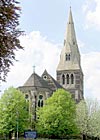For this church:    |
|
| NAVE | CHANCEL | TOWER | |
| Main | Plain rafters pitched N-S supported on posts with curved braces at ends. Plain boarded between the rafters. All 1863-4. | Curved braces and thin rafters with plain boards in polygonal form to fit around the apsidal shape of the chancel; 'vault' like in construction. All 1863-4. | |
| S.Aisle | Simple lean-to design but with curved braces and side purlins. 1863-4. | n/a | |
| N.Aisle | Simple lean-to design but with curved braces and side purlins. 1863-4. | n/a | |
| Other principal | |||
| Other timbers |
Bellframe
Fabricated steel frame of 2003, now with 10 bells, replacing a substantial timber bellframe, built for 6 bells but augmented to 8 on completion in 1864.
Not scheduled for preservation Grade 5.
Walls
| NAVE | CHANCEL | TOWER | |
| Plaster covering & date | No plaster. All built with open stonework. | No plaster. All built with open stonework. | No plaster. All built with open stonework. |
| Potential for wall paintings | None. | None. | None. |
Excavations and potential for survival of below-ground archaeology
No archaeological excavation has been undertaken at this church.
The fabric of the entire building dates from 1863-4 on a new site which was previously used as unenclosed common land. It is expected that the entire stratigraphy will date from 1863-4.
The churchyard is rectangular, adjacent to roads on its north, east, and south sides. The church itself is offset to the east of the churchyard. It has not been used for burials.
The overall potential for the survival of below-ground archaeology in the churchyard, is considered to be LOW comprising construction evidence from 1863-4, paths, and landscaping. Below the present interior floors of the nave and chancel it is considered to be LOW being principally stratigraphy from the 1863-4 building. The archaeology of the upstanding fabric is principally that of a single building phase of 1863-4 and is representative of the architecture of Thomas Chambers Hine; as a representation of local, mid-Victorian archaeology its potential is HIGH. There is an UNKNOWN potential for earlier stratigraphy relating to the site prior to its use as a church.
Exterior: There are no burials. Deposits around the church may contain evidence of the 1863-4 construction.
Interior: Stratigraphy under the entire building is likely to comprise, almost exclusively, 1863-4 and later deposits. Upstanding fabric largely intact from the same period.






